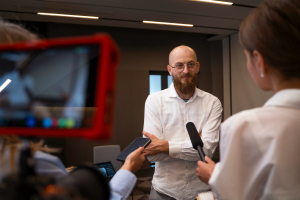-
.
Gareth Davies
Media Training - The importance of Eye Contact
Why Eye Contact Is the Game-Changer You’re Probably Overlooking
This week, I sat in on a presentation that reminded me of something so fundamental — yet so often overlooked — in both presenting and media interviews: eye contact.
The presenter had clearly put time into their slides. Their content was solid. But something felt off. And then it hit me — there was no real connection. They were looking above the audience, glancing at their notes, speaking into the space, but not to the people in the room.
It was a powerful reminder of just how important eye contact is — and why it’s something we work on so much in our media training sessions here at The Presenter Studio.
The Power of Eye Contact — More Than Just a Gaze
Eye contact isn’t just about where you’re looking. It’s about how you’re making people feel. And the benefits of getting it right go far beyond just ticking a box on your “body language” checklist.
Here’s what strong, intentional eye contact helps you achieve:
1. Warmth and Connection
At its core, communication is about connection. When you make eye contact with someone, even briefly, you signal: I see you. I value you.
In a presentation setting or during a media interview, this helps build a sense of trust and approachability. The audience feels included rather than talked at. It turns your delivery from a lecture into a conversation.
In our media training, we coach clients to look directly into the eyes of their interviewer, their camera lens, or key people in the audience. Why? Because it softens your tone, humanizes your message, and makes everything feel more genuine.
2. Pulling People In
Without eye contact, your audience can drift — and fast. We live in a world full of distractions, and if you’re not making the effort to draw people in visually, they’re more likely to tune out.
A well-timed look in someone’s direction can re-engage them. It invites them back into the moment. It says, this part is for you. That kind of personal connection is what elevates a good talk into a memorable one.
3. Showing That You Care
When you look at someone while speaking, it shows you care about whether they understand you. Whether they’re with you. Whether they matter.
Too often, people speak over others — especially in media interviews or panels — without ever making eye contact. It can come across as dismissive, cold, or worse, arrogant. Just a moment of eye contact can shift that impression completely.
At The Presenter Studio, we teach media spokespeople to use eye contact to project empathy, credibility, and emotional intelligence — the things that separate a forgettable soundbite from a powerful moment.
4. Reading the Room (Literally)
One of the most underrated benefits of good eye contact? It helps you read the room.
When you actually look at your audience, you can pick up nonverbal cues: Are they nodding? Smiling? Looking confused? All of this feedback helps you adjust your pace, energy, or tone in real time.
In media interviews, this is crucial — especially when you’re on camera. If your interviewer looks puzzled, that might be your cue to clarify. If they’re leaning in, you know you’ve landed something.
No script or teleprompter can replace the real-time feedback you get through eye contact.
5. Grounding Yourself
Ironically, one of the best ways to calm your nerves when presenting or being interviewed is to make eye contact.
It gives you something to focus on other than your own anxious thoughts. It reminds you that you’re talking to real people — not just “an audience.” And it often results in a more natural rhythm and tone, helping you sound more confident and relaxed.
Why We Make Eye Contact a Priority in Our Media Training
Eye contact might sound simple, but it’s a skill — and like any skill, it can be learned and strengthened. That’s why it’s one of the core areas we focus on in our media training courses.
Whether you’re preparing for a high-profile interview, a panel discussion, or a brand presentation, we help you:
- Find your natural eye contact rhythm (not too much, not too little)
- Work with cameras and screens (where “eye contact” means looking into a lens)
- Use eye contact to manage nerves and build presence
- Avoid the “scatter-gun” effect of trying to look at everyone at once
Eye contact is subtle — but its impact is huge.
Final Thoughts: Never Underestimate the Eyes
What I saw this week wasn’t a terrible presentation. But it lacked heart. It lacked that intangible quality that makes a speaker memorable. And more than anything, it lacked connection — all because of something as basic as where the speaker was looking.
If you want your message to land, your story to connect, and your audience to care, eye contact matters. It’s the thread that ties everything together.
And that’s why, at The Presenter Studio, it’s never just about what you say — it’s about how you make people feel when you say it.
Ready to Improve Your Presence and Impact?
If you want to communicate with more confidence, warmth, and connection, join one of our media training sessions. Whether you're preparing for live TV, a boardroom pitch, or a keynote speech, we’ll help you master the techniques that make all the difference — starting with something as simple (and powerful) as eye contact.
Contact us today: https://www.presenterstudio.com/business-presenter-training/media-training
The Presentation That Went Wrong - And Why It’s Worth Talking About
The Presentation That Went Wrong — And Why It’s Worth Talking About
Yesterday, I sat through a presentation that was a good reminder of the mistakes people make. We’ve all been there - hoping to be inspired or at least informed, but instead finding ourselves distracted, disengaged, and looking at the clock.
But as frustrating as those moments are, they also offer something incredibly valuable: perspective. It was a reminder of how quickly a presentation can go off track - and how easily the audience’s attention can slip away - when you forget the basics.
At The Presenter Studio, we always say the fundamentals are everything. No matter how great your content is, or how beautiful your slides look, without the three fundamentals - Passion, Eye Contact, and First Impressions - your presentation is going to fall flat.
Here’s what happened yesterday, and how it reaffirmed just why we focus on these three pillars in every presentation skills course we deliver.
1. Passion — Because People Feel More Than They Listen
From the first minute of the talk, it was clear something was missing. The speaker walked on stage and began reading directly from their phone - eyes down, voice monotone, no connection to the room. It felt like they were going through the motions, not sharing something they cared about.
That’s the problem with passion - or the lack of it. When a speaker isn’t engaged, it’s almost impossible for the audience to engage either. Passion isn’t just about volume or excitement - it’s about authenticity. It’s about showing your audience that this matters to you. That you believe in what you’re saying.
In our presentation skills course, we spend time helping people connect to their why. Why does this topic matter to you? What excites you about it? And more importantly - how do you communicate that excitement so your audience feels it too?
People want to be inspired, not just informed. If you’re passionate, they’ll be curious. If you’re not, they’ll tune out.
2. Eye Contact - The Easiest Way to Build Connection
Next came the second missed opportunity: eye contact.
Throughout the presentation, the speaker barely looked up. Eyes were glued to their screen. If they did glance at the audience, it was fleeting — just long enough to lose their place and return to their phone. And that, right there, is the moment you lose trust.
When you’re presenting, you’re not delivering a script - you’re having a conversation. And just like in any good conversation, eye contact is what builds trust, connection, and attention. Without it, your audience feels like you’re not really speaking to them - just speaking at them.
It’s one of the most common challenges we help people overcome in our presentation skills courses. Nervous presenters often avoid looking at the audience altogether - which is understandable. After all, it can be off-putting if people seem disinterested, or are checking their phones or taking notes.
But the truth is, eye contact is one of the fastest ways to pull people back in. Look at them - and they’ll look back. Engage them - and they’ll engage you.
We teach simple techniques for building natural, confident eye contact, so that your delivery feels more like a conversation than a performance.
3. First Impressions - Set the Tone or Risk Losing the Room
Finally, let’s talk about what might have been the biggest issue of all: the opening.
The presentation started late - almost 20 minutes behind schedule. No explanation, no sense of urgency. Just a slow trickle into a talk that lacked any kind of spark or direction. The energy was low. The pace was slow. The opening meandered without making a clear point.
And in those first five minutes, you could feel the audience switch off.
This is something we can’t stress enough: First impressions matter. A lot.
In our presentation skills course, we focus heavily on crafting strong openings - because we know how vital they are. Whether it’s a keynote speech, a boardroom pitch, or a virtual webinar, your opening is your first and best chance to hook your audience.
Start with a story. Ask a provocative question. Set the agenda with purpose and clarity. Show them why this is worth listening to.
When you don’t, you give people permission to disengage. They’ll check their phones. They’ll stop listening. And once you’ve lost them, it’s incredibly hard to win them back.
The Takeaway: Get the Basics Right, and the Rest Will Follow
It’s easy to overcomplicate public speaking. Fancy slides, big words, dramatic pauses - they all have their place. But without the fundamentals - Passion, Eye Contact, and First Impressions - none of it really works.
What I saw yesterday reminded me of why we do what we do at The Presenter Studio. Our presentation skills course is designed not just to teach you how to present, but how to truly connect with your audience, own the room, and feel confident doing it.
Whether you're a business leader, a creative professional, or someone who just wants to feel more confident speaking in front of others, the fundamentals are the same — and we can help you master them.
Want to Present Like a Pro?
If you’re ready to elevate your communication and presentation skills, join one of our presentation skills courses today. Whether it's online or in-person, private coaching or group training, we’ll help you find your voice, own your story, and deliver with impact.
Because when the basics are strong, everything changes.
For more information on our presentation skills courses visit: https://www.presenterstudio.com/business-presenter-training/presentation-skills-training
Check out our latest Presenter Showreel
Check our latest presenter showreel from the team at The Presenter Studio...
This was for psychotherapistSophie Scottwho first came on the 1 day How to Make it as a Presenter workshop (next date is June 25th).
And then did the 1 to 1 with us where we shot the footage for her showreel.
We think it's amazing.
See what you think!
Huge congrats and thanks Sophie!
The future is bright...
https://www.youtube.com/watch?v=SCeJiBf5kxI&feature=youtu.be
How to overcome your nerves with public speaking

Public speaking can feel like stepping into a spotlight with your heart racing and palms sweating. The fear of stumbling over words or facing a judgmental audience is enough to make anyone nervous. However, with the right strategies, you can manage those nerves and deliver a speech with confidence. This guide explores practical ways to prepare, reframe your mindset, and connect with your audience to transform public speaking from a source of dread into an opportunity to shine.
Prepare to build confidence
Knowing your material inside and out is the foundation of a calm and confident delivery. Start by researching your topic deeply so you’re ready for questions or unexpected turns in the discussion. Create a clear structure for your speech, with an introduction that grabs attention, key points that flow logically, and a conclusion that leaves an impact. Practice your speech aloud multiple times, ideally in front of a mirror or a trusted friend, to refine your pacing and delivery. Recording yourself can also reveal habits like filler words or awkward gestures, allowing you to polish your performance before the big moment.
Reframe your mind
Nervousness often comes from how you view public speaking, but you can shift your perspective to see it as an opportunity rather than a threat. Instead of imagining a critical audience, picture yourself sharing ideas with friends in a casual conversation. Accept that perfection isn’t the goal, audiences value authenticity over a flawless performance. To build mental resilience, visualize yourself delivering a confident, engaging talk, with the audience smiling and nodding along. This simple mental exercise can rewire your brain to approach the stage with excitement rather than fear.
Use breathing techniques
Physical symptoms like a racing heart or a shaky voice can make nerves feel overwhelming, but controlled breathing can bring your body back to a state of calm. Practice diaphragmatic breathing by inhaling deeply through your nose for four seconds, holding for four, and exhaling slowly for six. Right before your speech, take a moment to do a few rounds of this breathing exercise to center yourself. If nerves spike during your talk, pause briefly to breathe and regroup, it looks natural to the audience and helps you regain control. Slow, intentional breathing signals your brain to relax, reducing the fight-or-flight response that fuels anxiety.
Connect with your audience
Feeling disconnected from the audience can heighten anxiety, but building rapport creates a sense of collaboration. Make eye contact with individuals for a few seconds to foster a personal connection. A warm smile or a quick question, like asking the audience to raise their hands if they relate to your topic, draws them in and breaks the ice. Pay attention to the audience’s reactions, such as nods or smiles, and adjust your tone or pace to keep them engaged. Starting your speech with a relatable anecdote or question can humanize you and make the experience feel like a shared journey rather than a solo performance.
Start off small
If public speaking feels like an insurmountable challenge, take it one step at a time to build confidence gradually. Consider joining a group like Toastmasters, where you can practice in a supportive, low-stakes environment. Share your ideas in smaller settings, like team meetings or casual gatherings, to get comfortable speaking up. Each successful talk, no matter how small, reinforces your ability to handle larger stages. After every speech, reflect on one thing you did well to cement positive habits and track your progress. If you need a hand, our Public Speaking Courses could help.
Turn nervous energy into enthusiasm
Nervousness isn’t always a bad thing, it’s energy you can channel into a dynamic delivery. Use natural hand gestures to add emphasis and release pent-up adrenaline. If the setting allows, move purposefully across the stage to engage the audience and burn off excess energy. Focus on your passion for the topic, letting your excitement shine through to overshadow any lingering nerves. Studies show that reframing anxiety as excitement can improve performance in high-pressure situations, so embrace that energy as fuel for an engaging talk.
Improve with every speech
Every speech is a chance to grow, and feedback is your tool for improvement. Ask trusted peers for specific input on aspects like clarity, pacing, or audience engagement. If possible, review recordings of your speeches to spot habits and track how far you’ve come. The more you speak, the more comfortable you’ll become, as public speaking is a skill honed through experience, not an innate talent. After each talk, ask a colleague or friend what resonated with them to gain insights that shape your next performance.
Believe in yourself
Overcoming nerves in public speaking comes down to preparation, a positive mindset, and consistent practice. By mastering your material, connecting with your audience, and channeling nervous energy into enthusiasm, you can turn fear into confidence. Start with small steps, embrace the learning process, and remember that every great speaker was once a nervous beginner. With time and effort, you’ll find yourself stepping into the spotlight not with dread, but with excitement to share your voice.
Business Presenter Coaching that Gets Results
Do you and your team at work do presentations, social media content, panels etc?...
We formed The Presenter Studio 11 years ago to help businesses find their own voice, develop their own style - to ditch the 'corporate' and find the 'personal'.
It's surprising how far behind businesses are when it comes to communications. Presentations are lacklustre. Social media content doesn't reflect the brand. And it's anything but creative.
At The Presenter Studio we are all about helping you and your business shine. Helping you stand out. Helping you maximise your potential and find your own voice. And we love it! We've worked with everyone from NIKE, to Prudential, to ASOS to The Ministry of Defence!
Drop me a message if you want to find out more about how we can help you and your business and your team. And also check out the website: https://www.presenterstudio.com/business-presenter-training
Why Every Professional Should Take a Presentation Skills Course
Why Every Professional Should Take a Presentation Skills Course
Strong presentation skills are no longer a nice-to-have—they're essential in today's competitive job market. Whether you’re pitching to clients, delivering team updates, or leading a workshop, the ability to present clearly and confidently can set you apart.
A presentation skills course gives you the tools to speak with authority and authenticity. You’ll learn how to build persuasive arguments, craft stories that connect with your audience, and deliver your message with confidence.
More than that, it builds your presence. Great presenters are memorable because they’re not just speaking—they’re performing. In our presentation skills courses, we teach you how to own the room, read the audience, and make a lasting impression.
Public speaking is also one of the top fears people have. But like any skill, it improves with the right guidance and practice. A good course provides a safe space to overcome anxiety and develop new strengths.
If you're aiming for career progression, leadership roles, or simply want to boost your communication skills, investing in a presentation skills course is one of the smartest professional moves you can make.
To find out more about how we can help you visit https://www.presenterstudio.com/business-presenter-training/presentation-skills-training or email This email address is being protected from spambots. You need JavaScript enabled to view it.
Essential Skills You’ll Learn in a Presentation Skills Course
5 Essential Skills You’ll Learn in a Presentation Skills Course
Enrolling in a presentation skills course can be a transformative experience. Whether you’re a business leader, manager, or new graduate, mastering these core skills will elevate your ability to communicate effectively.
One of the first skills you'll develop is structuring your presentation. You’ll learn how to open strong, deliver key messages with clarity, and end with a powerful conclusion that resonates with your audience.
Next, delivery techniques are key. A good course will train you in how to use your voice, gestures, and facial expressions to enhance your message. These techniques are what transform a dull talk into a memorable performance.
You'll also build confidence in managing nerves. Through guided practice and feedback, you'll learn techniques such as breath control and visualisation to stay calm under pressure.
A presentation skills course also teaches how to engage an audience. This includes the use of storytelling, rhetorical questions, and audience interaction to maintain attention.
Finally, you’ll gain the ability to adapt. From boardrooms to conferences, you'll learn how to tailor your delivery to suit different settings and audiences.
Each of these skills is covered in-depth in our presentation skills courses, ensuring you're ready for any speaking challenge.
To find out more about how we can help you visit https://www.presenterstudio.com/business-presenter-training/presentation-skills-training or email This email address is being protected from spambots. You need JavaScript enabled to view it.
How to Choose the Right Presentation Skills Course for Your Needs
How to Choose the Right Presentation Skills Course for Your Needs
Finding the right presentation skills course can be overwhelming, especially with so many options available online and in-person. Whether you're looking to overcome your fear of public speaking or want to polish your delivery for professional settings, choosing the right course is key to your development.
First, consider your goals. Are you preparing for business presentations, keynote speeches, or client pitches? Look for a course that specifically mentions training for those situations. For instance, our presentation skills courses are tailored to real-world professional scenarios, which means you'll learn practical skills that you can apply immediately.
Another factor is the teaching style. A good course blends theory with plenty of practice. You should expect coaching on structure, storytelling, body language, and vocal delivery. The best courses provide personalised feedback, which is crucial for improvement.
Also, check who delivers the course. Are the trainers industry professionals? Our coaches come from a media background, offering insider insight into how to present with impact and authenticity.
Finally, reviews and testimonials can tell you a lot. Look for courses that are consistently praised for building confidence, clarity, and communication skills.
By identifying your goals and choosing a well-reviewed, professionally-led course with practical experience, you’ll be well on your way to becoming a more confident speaker.
To find out more about how we can help you visit https://www.presenterstudio.com/business-presenter-training/presentation-skills-training or email This email address is being protected from spambots. You need JavaScript enabled to view it.
Public Speaking Courses: Building Confidence and Communication Skills
Public speaking is more than just a skill—it's a doorway to personal and professional growth. Whether you're leading meetings, presenting ideas, or speaking at events, the ability to communicate clearly and confidently can elevate your career and build your credibility.
Many people struggle with public speaking due to fear or lack of experience. That’s why a structured course can make all the difference. At Presenter Studio, we create a safe and supportive space where you can build your confidence, practice your skills, and receive personalised feedback from experienced coaches.
Our courses are built around real-world speaking scenarios. You'll learn how to craft persuasive messages, engage audiences, and manage nerves. We don’t believe in one-size-fits-all teaching—instead, we tailor our coaching to each individual’s style and goals.
Confidence comes from experience and preparation. We guide you through practical exercises that help you understand your strengths and improve on your weak spots. From learning how to project your voice to developing your own speaking style, our courses cover all the essentials.
One of the unique aspects of our approach is our media background. Our training blends the performance skills of broadcasters with the authenticity needed for live audiences. This gives you an edge, whether you're speaking at work, at conferences, or on camera.
Explore how our public speaking courses can help you communicate with impact and confidence in any setting.
To find out more about how we can help you visit www.presenterstudio.com or email This email address is being protected from spambots. You need JavaScript enabled to view it.
Media Training Essentials: Navigating Interviews and Public Appearances
Navigating the media landscape can be intimidating, but with the right tools and mindset, you can handle interviews and public appearances with confidence and control. Whether you're preparing for a television interview, podcast appearance, or live panel discussion, the principles of good media communication remain the same.
At Presenter Studio, we help individuals and organisations build the skills needed to manage media interactions effectively. One of the most important aspects of media training is message preparation. Know what you want to say, and say it clearly. Focus on three key points you want your audience to remember and repeat them when possible.
Equally crucial is learning how to stay composed under pressure. Journalists may challenge you or ask difficult questions. Staying calm, redirecting with grace, and sticking to your message is key. Practice helps tremendously here—the more familiar you are with answering questions, the more natural it becomes.
Media training also involves learning how to use soundbites effectively. These are short, impactful statements that are easy for the media to use and easy for audiences to remember. Crafting a few solid soundbites in advance can give you confidence and make your message stick.
Presentation also matters. Body language, tone of voice, and appearance all influence how your message is received. Good media training includes coaching on posture, eye contact, and speaking style to ensure you come across as confident and credible.
If you're preparing for media appearances or want to improve your media presence, our expert-led media training programs provide the skills and feedback you need to
succeed.
To find out more about how we can help you visit www.presenterstudio.com or email This email address is being protected from spambots. You need JavaScript enabled to view it.










